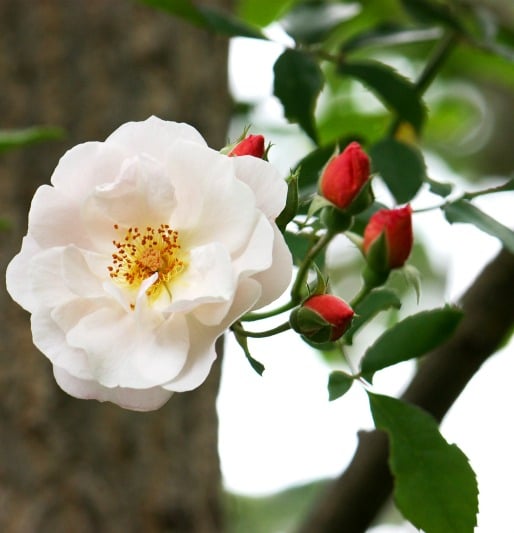
There’s no denying it; soon cold winds will be blowing and dormancy creeping into perennial and woody plants. Roses often defy the season, with September’s flush of buds and flowers still hanging on. Should I leave blossoms and buds on the plants, so that a frost will tell these plants to shut down, or should I take the opportunity to cut what’s left for a vase? Usually I do a bit of both. My favourite climber, ‘Clair Matin’, has a ginkgo tree for support, and they’ve been great pals for several years. I often take some of the last shell-pink blossoms indoors, along with a sprig of still-green ginkgo foliage. They don’t last long in a heated house, but I can’t resist.
Now is not the time to prune roses, although shortening overly long canes that might whip around in winter wind is a good idea. However, autumn is a good time to move a rose bush, should you be so inclined. The first weeks of November are best, after foliage has dropped and several nights of hard frost have brought it into partial dormancy. (Full dormancy won’t occur until mid to late December.) No one likes the idea of moving a rose, fearing the upheaval will do irreparable damage. But in its docile, partially dormant state, a gentle move to a new and better location won’t faze it at all.
Gently dig the rose shrub out, using a spade to loosen the root ball in a circle around the plant. Lift the root ball and put it into a wheelbarrow or onto a tarp for transport to the new hole. Don’t worry if the root ball shatters and the roots are exposed; they’re inured to brief exposure at this time. Just quickly cover them loosely with plastic for the journey to the new location. Amend the soil from the new hole with organic materials like shredded leaves, composted manure or garden compost.
Plant the rose shrub in its new hole with its bulbous graft two to four inches (5 to 10 cm) below soil level. Backfill halfway with the amended soil, and fill the hole with water. After it drains, fill the hole with the remaining soil. To protect the newly replanted rose during its first winter in a new location, hill up around the rose crown with 12 inches (30 cm) of fresh soil and add a thick layer of leaf mulch. I use a generous 12 inches (30 cm) of leaves piled over the hilled soil. Now, wasn’t that easy?

Hi Linda.
Thanks for the great info. I’m planning on transplanting my Hybrid tea rose this November as you suggested. I usually cut back my rose bushes in the early spring. I was wondering if would be better if I cut back the rose bush in November prior to transplanting it. Any advise please?
Thanks
Frankie
Hi Judith and Beckie,
Just reread your “Moving Roses” article, since I anticipate doing that this fall.
Are you familiar with Katherine Barber’s wonderful Wordlady blogs? The use of “phase” for “faze,” a very common mistake, put me in mind of her:
https://katherinebarber.blogspot.com/search?q=faze
Hello Linda. Oops! Thank you for pointing that out. Now corrected.
Is this also advice for Zone 4 – Edmonton, Alberta?
Hello Carolyn, The author of the item on moving roses lives in Toronto, Zone 6. My instinct is that with proper winter protection, this technique would work in your zone. However, to be sure, perhaps you could find a local rose grower to consult.
Hi Andrea,
You’re right on time for moving those roses. Go to it!
— Judith
Hi Brigitte,
Thanks so much for sharing that experience! What a struggle, and obviously you now have the rewards with sweet flowers in autumn. ‘Sir Thomas Lipton’ is prone to throwing some autumn blooms, so he must be feeling just fine.
If you purchase bare-root roses, you’ll notice that they often have their long wispy roots trimmed. That lets us know it does no harm if some of the thinnest roots are severed or lost in the process of moving. Roses tolerate quite a lot of shifting in the month of November, when they’re almost ready for a long winter dormancy. I wouldn’t attempt moving them in spring, because they begin to break dormancy very early, and then are more sensitive to disturbance. I’m not that brave.
–Judith
About this time last year, due to impending renovations, I had to move my Sir Thomas Lipton rose (either that or risk getting it trampled). Guessing by the 1993 coin I found trapped in its roots, it was a mature plant. Not knowing any better, I hacked that 8′ tall bush down to about 2′, and then spent the better part of 3 hours trying to carefully dig up the roots. I’m ashamed to say that frustration got the better of me and I started to get careless. Those roots went down deep – at least 3′, and I was tired! So I yanked hard and ripped out the beast, leaving most of the root tips behind. I replanted the roots and defoliated stump in a new hole, about 2′ deep max, and just threw the old dirt back on it. Come springtime, I was certain it had succumbed to its injuries. With all the rain we had here in Halifax this past spring and summer, I never got around to doing much gardening, let alone pulling it out. Good thing – not only did it survive, it produced a strong flush of sweet flowers last month! Just goes to show you how tough those old roses can sometimes be!
This is so timely! I have a couple of Rose shrubs I am thinking of moving but I was wondering if I had left it too late for this year. Now I know! Thank you!